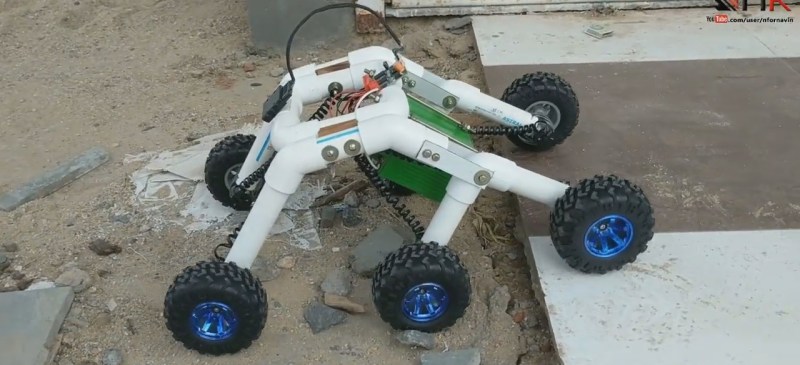[Navin Khambhala] is a master at making simple what most would expect to be a complex build. Now he’s done it again with a remote controlled robot that can easily climb steps and role over rough terrain. The parts count is small and many of them are commonly available.
The suspension that makes it all possible is the rocker-bogie. It’s the same suspension we’ve all seen used by the various rovers ambling around on Mars. The whole frame is made of PVC pipes with some connecting metal bars, and each wheel has its own twelve-volt DC motor. Motor control is done simply with a module that combines the 2.4 GHz receiver with motor controllers. When you watch the video below, note where only one hole is drilled through the PVC for making connections instead of two holes. Where there’s only one hole, the two sections of PVC are free to rotate independently of each other. Turning the robot is done by rotating the wheels on one side in one direction and the wheels on the other side in the opposite direction. This is called a differential drive or tank drive, and we’ve highlighted it before for use in making hamster-drive type BB-8 droids.
Can this robot be made simpler still? Well, it’s been almost a decade but we’ve previously shown this stair climbing robot that doesn’t use a rocker-bogie suspension, but it sure borrows some of the same ideas for rolling up those stair-faces.
















Someone should update the Dalek…for stairs.
True! They’re well overdue for new voice firmware too.
EX-TER-MIN-ATE
EX-TER-MIN-ATE
No need to as they have been able to fly or levitate on Earth since about 2010 or 2011.
Try 1988 – Remembrance of the Daleks – cliffhanger for the first episode.
https://www.google.co.uk/imgres?imgurl=https%3A%2F%2Fi0.wp.com%2Fblogtorwho.com%2Fwp-content%2Fuploads%2F2016%2F10%2FDW_Flying_Imperial_Dalek.jpg%3Fssl%3D1&imgrefurl=https%3A%2F%2Fblogtorwho.com%2Fon-this-day-in-1988-the-daleks-conquered-the-stairs%2F&docid=JRf7VaoKYYIUyM&tbnid=dDm1H4ySAEZM8M%3A&vet=10ahUKEwiWv6DFqNTVAhUpAcAKHSIPAT8QMwiUAShOME4..i&w=800&h=600&bih=950&biw=1920&q=remembrance%20of%20the%20daleks&ved=0ahUKEwiWv6DFqNTVAhUpAcAKHSIPAT8QMwiUAShOME4&iact=mrc&uact=8
What I’m surprised is that after all these years, I still can’t find anything on Google about a rideable version I can take off-road. Is there some quirk about these that makes them suck for passengers? Wouldn’t we have been better off sending a tried and true 4×4 buggy to Mars? Off-roading is hardly an unknown science for humans, it’s been studied and tinkered and hacked enough to be a high art.
This lack of Terran representation of the Rocker-Bogie system suggests it was sent to Mars for it’s “cool” factor, rather than it’s optimal ability to drive off-road.
I’m going to disappoint you, after all these years it was one Google search away. The Rocker-Bogie system is limited in its top speed, about 3 inches per second (convert that to metric as appropriate).
That isn’t a design limitation. That is a NASA limitation to avoid accidents and damage. They can’t exactly go and pick it up if it tips over on Mars. Speed needs to be reduced greatly when climbing for obvious reasons, but operation over flat or simple uneven terrain, decent speeds can be used.
Get yourself an old Scammel, they have similar rear suspension and are also awesome.
Nice build, simple construction and informative video but it seems it has missed a vital point of the rocker-bogie design as used in all the Mars rovers from Sojourner to Curiosity. And that is, the two sides of wheel sets are linked through a differential pivoting system in or above the chassis so that when one side front wheel is raised, the opposite side wheel is forced down:
http://www.wireless-earth.de/private/common_images/RockerBogieSuspension.jpg
That way the chassis is kept at the average level of both sides. You don’t see this model negotiating steps at a 45 degree angle which would demonstrate the effectiveness of the differental pivot, if it had one. In Sojourner the pivot was an internal differential inside the chassis box but on Spirit, Opportunity and Curiosity the design changed to an extremely mechanically simple external transverse lever and ball-and-socket arrangement across the top of the body.
As to why this design is not seen in terrestrial vehicles? I’d say it was because it is really suited to slow-speed driving. And with the high centre of gravity, the lack of need for a averaging-level chassis and overall complexity necessitating hub motors rules it out over vastly simpler designs such as the articulated pivoting hull used in the Coot 4×4 ATV, which derived from the M561 Gama Goat.
Would like to see the builder do a Version 2 with the differential sides, it wouldn’t take much to add to this fun model!
thanks for that comment – I was wondering why there was only straight ahead climbing shown in the video, then I realized, it is because the design cannot really cope with angled “climbing” tasks. A differential might help considerably.
There needs to be a little Lego man in a cockpit to drive it. I think that would look cool.
Great job by the way.
Disliked due to clickbait background music.
Annoyed as well, would prefer a brief play-by-play (or *any* voice over) by the maker.
I want to this robot circuit diagrame
How much weight can it carry?